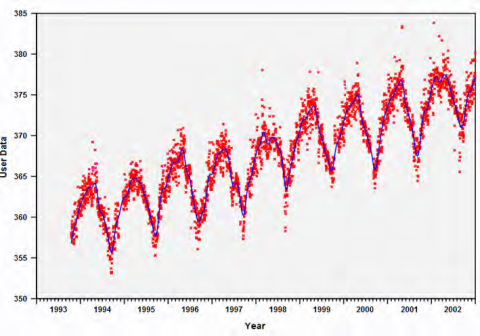
This site provides offline tools and online applications for data analysis and visualization, especially for those data included in the Global Environmental Database (GED) at the Center for Global Environmental Research (CGER). The online trend analysis application let users quickly extract seasonal variations and inter-annual trends from their time series observations. The air trajectory application for single Lagrangian particle can be both used online and downloaded for offline use. An application server at CGER has prepared several meteorological datasets for air trajectory computing.
Trend Analysis
The online trend analysis tool uses Fast Fourier Transform and Thoning’s filter [Thoning et al., 1989, J. Geophys. Res., 94(6):8549-8565] to remove the short-term variations from a time series observation and obtain a long-term variation and trend. The tool is designed particularly for extracting the trend and increase rate of a daily mean atmospheric pCO2 data. Users can paste their data into the data box of the interface, set the cut-off frequency, and then get the filtered results and coefficients.
http://db.cger.nies.go.jp/portal/analyses/trend
Trajectory
The Meteorological Data Explorer (METEX), developed at the Centre for Global Environmental Research (CGER), includes programs for online calculation of air trajectory and visualization of meteorological fields. It converts datasets from European Center for Medium-Range Weather Forecast (ECMWF), National Centers for Environmental Prediction (NCEP), and Japan Meteorological Agency (JMA) in various binary formats to a standard format to give users the option of using different meteorological data. Registered users can use the web-based batch calculation service to obtain a large number of trajectory results with one submission.
http://db.cger.nies.go.jp/portal/analyses/trajectory
Footprint
FLEXCPP is a Lagrangian particle dispersion program written in C++ based on FLEXPART Version 6.4. The intention is to implement parallel computing to accelerate modelling. In our experiment with multi-cores computers, the performance gain was proportional to the number of cores. In a computer with a NVIDIA GPU, the performance improvement was more than 20 times. The program have been used to compute the footprint (mean residence time of Lagrangian particles near the surface) for Hateruma and Ochi-ishi stations.
http://db.cger.nies.go.jp/portal/analyses/footprint



